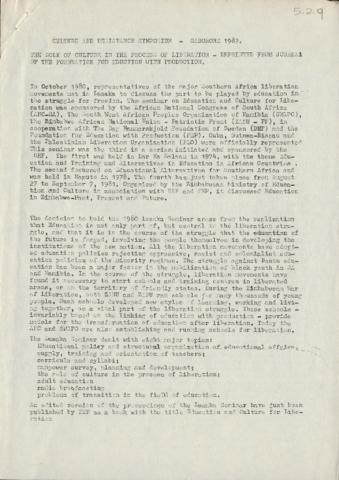Identity area
Reference code
Title
Date(s)
- 1982 (Creation)
Level of description
Subseries
Extent and medium
9 pages
Context area
Name of creator
Administrative history
The Medu Art Ensemble was formed by South Africa exiles in Gaborone, Botswana, in 1978. The organisation produced a wealth of creative work across all major art-forms; the roup further played a key role in shaping aesthetic and cultural theory and praxis within Africanist and liberation struggles. On June 14 1985, the South African Defence Force attacked the homes of Medu members and other activists in Gaborone, killing 12 people; Medu as an organisation ceased to exist.
Name of creator
Biographical history
Name of creator
Biographical history
Repository
Archival history
Paper presented at the Culture and Resistance Symposium, Gaborone, 5-9 July 1982.
Immediate source of acquisition or transfer
Content and structure area
Scope and content
Culture and liberation are intimately related. Life, according to the authors, is a process of struggle to reach higher levels of civilisation, a process in which art is deeply embedded. The struggle against Apartheid and different forms of colonial violence is one which is intertwined with culture and artistic expression. Even once equality is reached within society, a further cross-pollination of cultural ideas and forms will occur leading to a richer, popular and more universal culture.
Appraisal, destruction and scheduling
Accruals
System of arrangement
Conditions of access and use area
Conditions governing access
Conditions governing reproduction
Permission to publish must be obtained from the Medu Art Ensemble Project.


